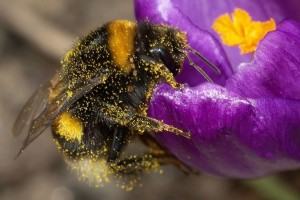Pollinator Update: The Bumblebee on the Endangered List and What That Means to You
 For the first time in the U.S., a bumblebee has been placed on the endangered species list. After much debate, and some delay from the Trump Administration, the rusty patched bumblebee was officially added to the list in late March — a full month after the U.S. Fisheries and Wildlife Service (USFWS) recommended the insect be added.
For the first time in the U.S., a bumblebee has been placed on the endangered species list. After much debate, and some delay from the Trump Administration, the rusty patched bumblebee was officially added to the list in late March — a full month after the U.S. Fisheries and Wildlife Service (USFWS) recommended the insect be added.
Just 20 years ago, the rusty patched bumblebee was a common sight across 28 states from Connecticut to South Dakota, the District of Columbia, and two Canadian provinces. Since the late 1990s, the rusty patched bumblebee has experienced a swift and dramatic decline, leaving only a few small, scattered populations in nine U.S. states and one Canadian province, according to the USFWS. The endangered designation means that the rusty patched bumblebee is in danger of becoming extinct throughout all or a portion of its range.
“Our top priority is to act quickly to prevent extinction of the rusty patched bumblebee,” says USFWS Midwest Regional Director Tom Melius. “Listing the bee as endangered will help us mobilize partners and focus resources on finding ways right now to stop the decline.”
Decline of the rusty patched bumblebee is attributed to disease, pesticides, the effects of climate change, habitat loss, and the effects of small population dynamics. Regarding pesticides, the USFWS states that while most studies examining the effect of pesticides on bees have been conducted using the European honey bee, bumblebees may be more vulnerable to pesticides than honey bees.
The rusty patched bumblebee is not the first bee to be listed endangered, as seven species of yellow-faced bees native to Hawaii were the first bees in the country to be protected under the Endangered Species Act, added last fall.
A recent report on NewScientist.com highlights how drones that can pollinate flowers might one day work side by side with bees to improve crop yields. Learn more here.
EU and States Line Up to Ban Neonics
The European Union is leaning toward a permanent, all-out ban of neonicotinoid use in fields, citing “acute risk to bees,” according to a March 27 article in The Guardian. The proposals could be voted on as soon as this month, and if they are approved by the majority of EU member countries, a ban could be implemented before the end of 2017.
The EU imposed a temporary ban on the use of three active ingredients (imidacloprid, clothianidin, and thiamethoxam) on some crops in 2013; the newest proposals are for a complete ban on neonic use in fields. However, the plants grown in greenhouses are the only exceptions to the ban currently, The Guardian reports.
In the U.S., legislation to protect pollinators from neonicotinoids has been introduced in several states, and bills to ban neonicotinoids have passed in Maryland and Connecticut. Maryland was the first state to ban the use of the chemical class by consumers. The ban will be enacted beginning Jan. 1, 2018. The Connecticut bill specifically focused on making all neonicotinoids restricted-use pesticides.
North Carolina is the most recent state with legislation pending that would also target neonicotinoids. The Pollinator Protection Act (H.B. 363), filed in mid-March, would outlaw consumer use of neonics, but would not stop farmers, licensed pesticide applicators, and veterinarians from using them. Neonicotinoid product manufacturers including Bayer and Syngenta, both headquartered in Research Triangle Park, NC, oppose the bill.
The lead sponsor of the bill, North Carolina state Senator Pricey Harrison, said in a March 20 article in Raleigh’s newspaper, The News Observer, that the measure is similar to legislation that passed in Connecticut and Maryland. According to Harrison, 18 other states are also drafting “some sort of pollinator protection, much of which deals with the neonic issue.”
In The News Observer article, Harrison said the bulk of neonic use is by professionals, who would not be affected by the legislation.
“So it’s not really going to significantly impact the industry, but it will limit use to those who have some expertise,” she said.
Harrison said in the article that the feeling, at least among state lawmakers in North Carolina, is that with less supervision at the EPA due to the election of President Donald Trump and his appointment of Scott Pruitt as the EPA administrator, it’s going to be up to the states to enact necessary legislation to protect pollinators.
Check out the Best Management Practices for Bee Health in the Horticulture Industry guide available from the Horticultural Research Institute.
MPS Helping Growers be Proactive
According to MPS – More Profitable Sustainability, a European-based environmental certification organization, more and more growers are signing up for sustainability certification. And crop protection companies are also meeting with MPS to get on board with its color-coding system. This way when they work with growers to trial new crop protection programs, they can let them know the MPS color the product falls under.
Next year at the 2018 California Spring Trials, MPS will be training growers on its ProductProof program, a kind of seal that indicates at the product level that certain active ingredients have not been used in cultivation. The program was developed in 2016 and is being rolled out in Europe this year, as retailers there are mandating that product be labeled, says MPS’ Arthij van der Veer. ProductProof is an add-on for the MPS-ABC program. Growers using it have to be participating in the MPS-ABC certification program, and input daily registration of crop protection use, among other requirements. Look for more information in upcoming news on MPS.
Meanwhile, learn about what researchers from the University of Florida have found is the best pollinator insect-related term for promoting plants.
New Tools for Insect Control
As growers’ chemical toolboxes get lighter due to state and retailer restrictions, crop protection manufacturers are making an effort to introduce new chemical and biological controls, and growers are focused on widening their knowledge and practice of integrated pest management.
Meanwhile, crop protection tools introduced since 2014 on the chemistry side include:
- Mainspring (cyantraniliprole) from Syngenta
- Rycar (pyrifluquinazon) from SePRO
- Sultan (cyflumetofen) from BASF
Bayer announced registration for its new butenolide class insecticide, Altus, with the active ingredient flupyradifurone, now available as of May 1, 2017.
According to Greenhouse Grower’s 2017 State of the Industry survey, 63% of growers of all sizes are using biocontrols. Greenhouse Grower’s 2017 Top 100 Growers Survey reveals 83% are using biocontrols, including beneficial insects, biopesticides, biostimulants, and biochemicals. Of the Top 100 Growers, 23% say they are just beginning to incorporate biocontrols into their IPM practices, 35% are advanced, having used biocontrols for a few years, and 25% consider themselves to be experts and have used biocontrols for several years.









